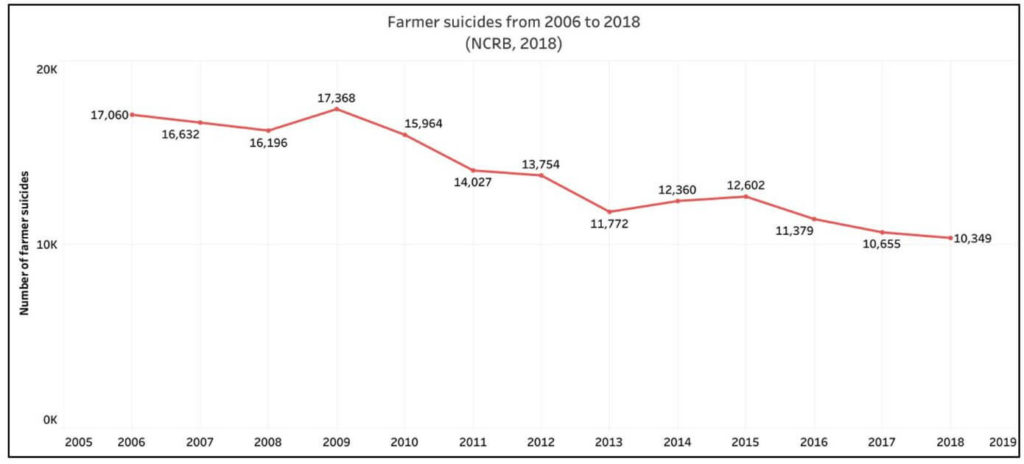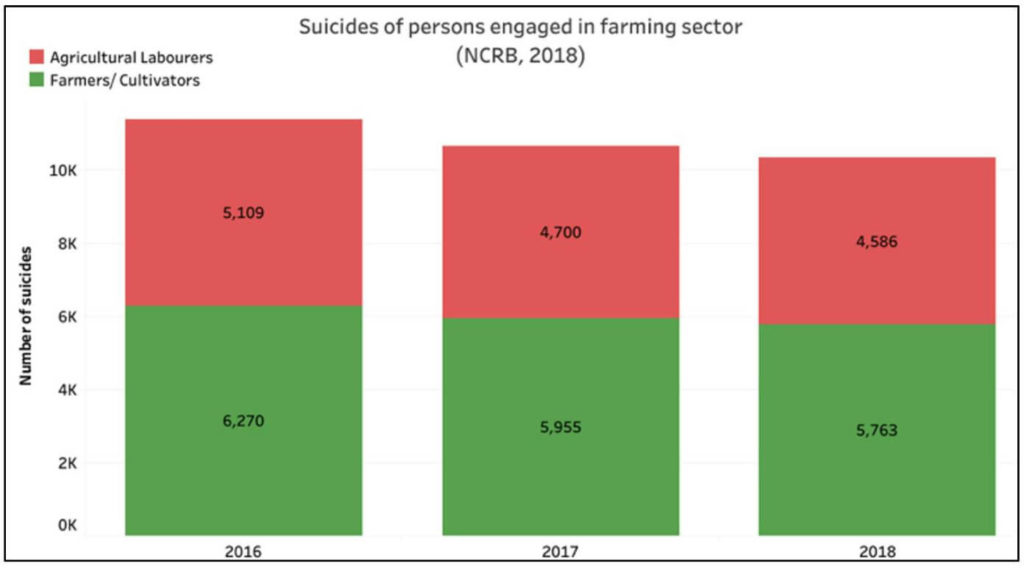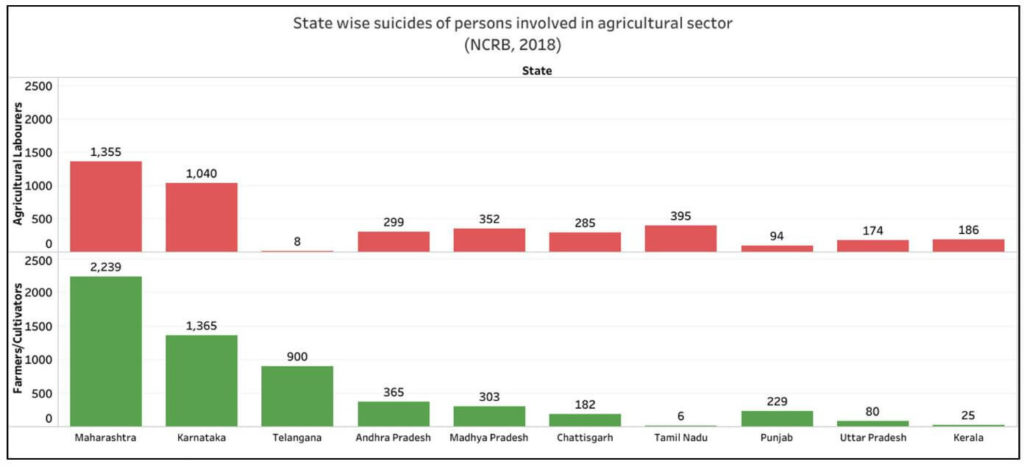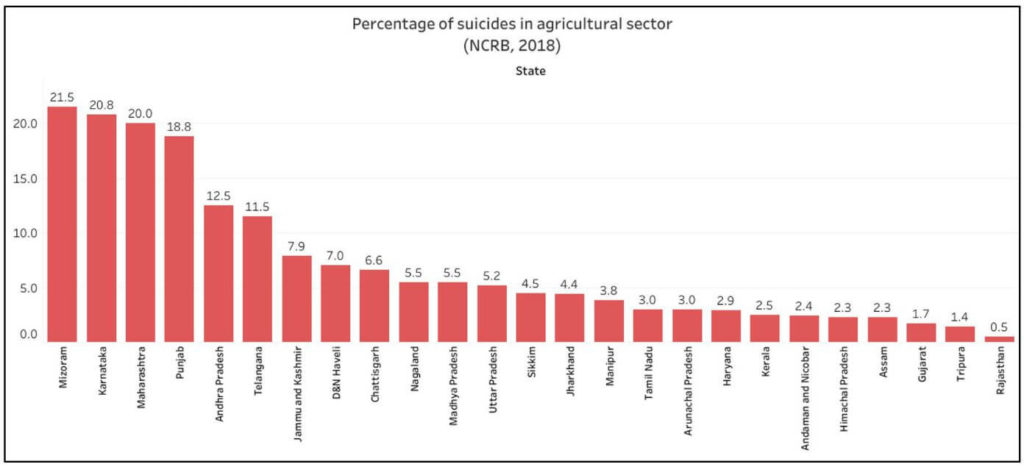NCRB’s 2018 report on ‘Accidental Deaths & Suicides’ reveals that the number of farmer suicides is at a 12-year low in 2018. But how reliable is NCRB data? Do we have enough data to understand the problem in its entirety?
Vast majority of rural Indian population is still dependent on agriculture. The ongoing agricultural distress has taken a toll and it is evident from the large number of farm related suicides over the last two decades. Unsustainable agriculture, indebtedness and climate change driven weather patterns have only exacerbated the problem.
The National Crime Records Bureau ( NCRB’s) report on ‘Accidental Deaths and Suicides in India’ has revealed that the number of farmer suicides has dropped in 2017 and 2018. But does the data give an actual picture of the reality?
Suicides in agricultural sector reach a 12-year low in 2018
According to the data reported in the NCRB report, suicides in the agricultural sector in India reduced to 10,655 in 2017 and 10,349 in 2018. The number of suicides in 2018 is the lowest in the 12-year period starting in 2006.
The number of suicides reduced by 6.2% in 2017 compared to the year before. However, the reduction in 2018 was only 2.9%. In 2017 & 2018, suicides of those in the agricultural sector as reported by NCRB accounted for 8.2% and 7.7% respectively, of the total suicides recorded in India.

NCRB presents data on farmer suicides in terms of farmers/cultivator and agricultural labourers. Farmers or cultivators are those whose profession is farming whereas agricultural labourers are those who work in the farming sector or in other words, they earn income from agricultural labour activities.
Around 56% of the suicides in the sector are of ‘farmers or cultivators’
Since 2016, the percentage of farmers/cultivators who committed suicide revolved around 56% while the percentage of agricultural labourers who committed suicide constituted the remaining 44%. In 2017 and 2018, female farmers made up for 5% of the total farmer suicides. In the case of agricultural labourers, around 11% of the reported suicides were of female labourers. In 2017, one transgender labourer was also reported to have committed suicide.

Proportion of suicides by farmers owning the land they cultivate has increased in the last three years
Based on land ownership, there are two types of farmers or cultivators- those who cultivate on their own land and those who cultivate on leased land or other’s land. While the numbers show a decline in number of farmer suicides, proportion of farmer suicides who owned the land they cultivated has increased from 84% in 2016 to 87% in 2017 and 88% in 2018. Of the incidents reported, around 4.8% of the farmers who had owned the land they cultivated and 9.4% of those who did not own were females.

Maharashtra continues to account for one-third of the Farm related suicides
State-wise analysis of these suicides reveals that Maharashtra continues to account for more than one-third of the cases reported across the country. Karnataka (23%) has reported the second-highest number of incidents followed by Telangana (9%). Ten states with the maximum number of suicides in 2018 accounted for more than 95% of the suicides in the country.
Of all the suicides across the country, 39% of the farmers/cultivators suicides were reported in Maharashtra and 24% in Karnataka. 99% of the suicides reported in Telangana were that of farmers/cultivators. In smaller states such as Mizoram and Manipur, all the cases reported were that of farmers/cultivators.
In the case of agricultural labourers, 38% of the incidents were in Maharashtra, 23% in Karnataka and 9% in Tamil Nadu. More than 98.5% of the suicides in the farming sector in Tamil Nadu were that of agricultural labourers. Same is the case in Kerala, Gujarat, Assam, and Jammu and Kashmir. All the cases of suicides reported in the farming sector in Haryana (104), Jharkhand (58), Tripura, Arunachal Pradesh and Nagaland were that of labourers.

21% of all the suicides in Karnataka are Farm related
Analysis of the proportion of suicides of those in the agricultural sector compared to the total number of suicides in a state shows that 21.5% of the suicides in Mizoram were farm-related. However, the total number of suicides in Mizoram was only 79. Of the bigger states, suicides in the farming sector accounted for 20.8% of the total suicides in Karnataka followed by 20% in Maharashtra and 18.8% in Punjab.

The states of Bihar, Goa, Meghalaya, Odisha, Uttarakhand, and West Bengal have reported zero suicides of farmers or agricultural labourers in 2018.
Are NCRB’s numbers reliable?
While the suicide data of NCRB is the only comprehensive source of such information, questions regarding the reliability of the data remain.
For instance, Odisha reported ‘zero’ suicides of farmers and agricultural labourers in both 2017 & 2018. However, if one goes by the answer provided by the Government of Odisha in the state assembly, the numbers look different. As per this answer, during the financial years up to March 2019, a total of 38 cases of farmer suicides were reported in Odisha. These numbers were presented in the state assembly by the agriculture ministry in July 2019. In 2016-17, 16 cases were reported. In 2017-18, 20 cases were reported and in 2018-19, 2 cases were reported. The government also added that none of these cases were due to financial burden or crop loss.
It has to be noted that the numbers reported by NCRB do not consider reasons for suicide. Hence there appears to be a clear conflict in the case of Odisha.
From 2016, NCRB has omitted certain key data on Farmer Suicides
Based on Odisha’s example, the possibility of underestimation of such suicides cannot be ruled out. Also, NCRB collects data from the State/UT Police and compiles the data. From the 2016 report onwards, NCRB has omitted key sections related to farmer suicides from the ADSI report. These include causes of farmer suicides such as personal issues, health issues, financial problems, or crop-related issues; landholding size such as marginal, small, medium, and large farmers.
Study by ISEC in 2017 classified reasons of farmer suicides
A study on farmer suicides was conducted by the Institute for Social And Economic Change (ISEC), Bengaluru in 2017 across 13 major states in the country which reported a high number of incidents. This study was commissioned by the Department of Agriculture & Farmers Welfare, Government of India.
As a part of the study, about 528 victim households were surveyed. The study classified causes of suicide into three main categories namely- social causes, farming related causes and debt related causes. The study recorded debt related issues, farming related issues and social causes separately for each of the suicide cases.
Under farming related causes, expectation of non- institutional credit was identified to be the reason behind 37% of incidents and failure of rain was the reason behind 36% of the incidents. Institutional loans were the reason stated by 44% of the households surveyed. Social issues include alcoholism and drugs, illness, daughter’s wedding, fall in reputation, family disputes and more. Alcoholism and drugs were reported in 26% of the cases. The study mentions that the act of committing suicide was a combination of several cumulative causes which can be grouped into social, farming and debt related. Or in short, there can be multiple reasons that might have led to suicide.
Multiple schemes rolled out for Farmers
Since agriculture is a state subject, the implementation of programs falls under the purview of state government. There are many schemes rolled out by governments for the welfare of farmers. States like Telangana, Odisha etc. have rolled out direct investment support to farmers. The Government of India is also doing the same under PM-Kisan. In addition, central government has floated the Pradhan Mantri Fasal Bhima Yojana for comprehensive insurance coverage for crops, Paramparagat Krishi Vikas Yojana for promoting organic farming, Pradhan Mantri Annadata Aay Sanrakshan Abhiyan to ensure remunerative price for products, Pradhan Mantri Kisan Samman Nidhi, a pension scheme for small and marginal farmers.
Need for more granular real-time data & mitigative measures
While the central government and various state governments are implementing multiple schemes for farmers, there is a need for more granular real-time data for one to understand the problem of farmer suicides in its entirety. Detailed reasons & profile of those committing suicide have to be captured to understand the extent & the underlying cause of such suicides. Mitigative measures should flow from these identified reasons.


